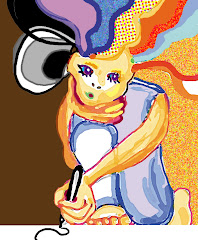Web 2.0 holds many possibilities for libraries to put information and publicity online.
This possibility relies on their manager/employer to put in place the ability to do so.
Some employers may think maintaining a blog or webpresence is too time consuming and not worth the trouble. They may think core business is all they have time for, given the few already busy staff they have.
This is not true.
Many libraries already produce library newsletters, fliers and media releases in order to promote their monthly activities. Cutting and pasting that already written content into a blog will really take very little extra time and yet have the potential to reach a much wider client audience, even reaching people who have not come into the library recently. These customers can subscribe to the blog and get regular updates on free workshops, reviews of new books, author visits, booktalks and children's activities that they can attend, boosting numbers and so making them more successful. This is turn justifies the funds spent in organising these events in the hope someone will attend.
Short speeches, films and photos can be posted that promote collections and local history information that the library holds. A local cemetry tour could become a slideshow that can be downloaded to an Iphone and used as a virtual guided tour by someone walking through the cemetry. Someone overseas researching family history can find a keyword indicating that there is a photo of their ancestor's grave included in that tour, and be able to make a virtual visit to the grave.
Libraries are all about reaching a wider audience with knowledge.
Trove has made a start with putting old newspapers online, and the response has been very enthusiastic.
The ability for readers to correct the text they see on screen or put a comment with more information under a photo is very interactive and builds on the knowledge presented without costing the site extra money.
What is the use of having valuable old records and photos locked away where few can access them?
Digitisation projects get these same items out on the web and being accessed, as well as providing a copy that cannot be ruined by fingers. A poster for a display takes time to produce and is taken down after a short time, but a poster and photos scanned and uploaded to the internet makes a display available worldwide for a long long time.
Other blocks to using Web 2.0 functions include library web filters that stop even the librarian accessing them; the inability to place widgets eg. for delicious on the top browser bar; and not having backroom or offdesk time to perform these tasks. Managers may see publicity as the job of a personal assistant and not see the need to produce a more attractive professional-looking product that librarians with layout or Indesign skills could supply. If other Council departments produce branded well-marketed fliers, then simple old style library fliers may start to look second rate. Public library computers need to have access to programs such as Adobe and Flash for customers to access interactive functions such as movies or online forms on sites. These require an IT department that is able to keep these updated and working. The library may need to buy a digital camera or scanner or send staff to training, but in the long run there is not a lot of extra money or time involved in getting an exciting web presence. The greatest obstacle is the permission to do so.
Tuesday, March 23, 2010
Problems librarians may face with blogs and Web 2.0
Labels:
blocks,
blog,
blogs,
brand,
family history,
filters,
interactive,
internet,
IT,
librarian,
libraries,
library,
local history,
management,
marketing,
permission,
photos,
problems,
Trove,
web 2.0
Subscribe to:
Comments (Atom)



